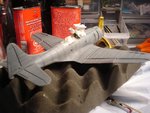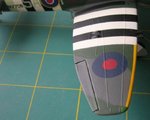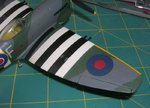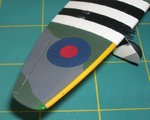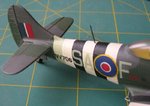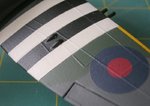Flash_Taco
Airman
Hello,
I have been reading this forum for about a month or so, but never participated until today. I am returning to modeling after approximately 30 years, although I was never an advanced modeler, but rather just an "assembler" of plastic aircraft kits. Two months ago I decided to buy the tools and supplies to start modeling in a more serious manner. I've read tons of info from the web and a couple of books to refresh and acquire new concepts about the hobby. This forum has proven an invaluable source of advice since I am halfway from complete my first model relatively trouble free (A 1/48 scale SBD Dauntless from Revell) Ok, that's enough introduction, here is my question:
I have airbrushed the model with Model masters enamel following a two color scheme (Lt. Gray on the bottom and Neutral gray for the top) I am satisfied with the looks, but now it's time for the "infamous" clear coat stage. While reading about the different coatings I learned that some of them tend to discolor to a yellow tone with time, and this can be prevented by using clear coats. One of the authors suggests Floquil's Cristal Cote as a good option. In preparation for this, I covered a styrene sheet with the same paint and let dry for 3 days and applied Crystal cote with an airbrush at around 20 psi and it looks nice and even. However, I want to know if any one here has experience with this particular coating and how to avoid the most feared "frosting" Are their any "secrets" as how to manage the dilution between thinner and cote? I just want to play safe before I coat my model (I keep a medium mallet on my workbench in case something goes wrong ... ) Also, do I need to buff the paint before the clear coat to reduce the grainy texture of the mate paint?
) Also, do I need to buff the paint before the clear coat to reduce the grainy texture of the mate paint?
Thank you all, and keep the good work.
I have been reading this forum for about a month or so, but never participated until today. I am returning to modeling after approximately 30 years, although I was never an advanced modeler, but rather just an "assembler" of plastic aircraft kits. Two months ago I decided to buy the tools and supplies to start modeling in a more serious manner. I've read tons of info from the web and a couple of books to refresh and acquire new concepts about the hobby. This forum has proven an invaluable source of advice since I am halfway from complete my first model relatively trouble free (A 1/48 scale SBD Dauntless from Revell) Ok, that's enough introduction, here is my question:
I have airbrushed the model with Model masters enamel following a two color scheme (Lt. Gray on the bottom and Neutral gray for the top) I am satisfied with the looks, but now it's time for the "infamous" clear coat stage. While reading about the different coatings I learned that some of them tend to discolor to a yellow tone with time, and this can be prevented by using clear coats. One of the authors suggests Floquil's Cristal Cote as a good option. In preparation for this, I covered a styrene sheet with the same paint and let dry for 3 days and applied Crystal cote with an airbrush at around 20 psi and it looks nice and even. However, I want to know if any one here has experience with this particular coating and how to avoid the most feared "frosting" Are their any "secrets" as how to manage the dilution between thinner and cote? I just want to play safe before I coat my model (I keep a medium mallet on my workbench in case something goes wrong ...
Thank you all, and keep the good work.
Last edited:

